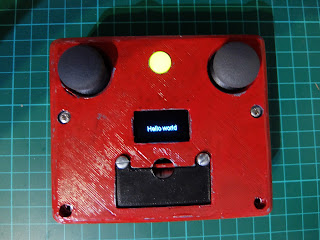It's been a long time, but check out the Electric Gerbil
I'm building a robot - one of these ball robots that seem popular at the moment. I've actually experimented quite a bit already. I found this project, which I like, because it allows the robot to spin on the spot. I have in mind that this might be an entertaining toy for a child. I also like the idea you can kick it! It's called Kickbot.
Anyway, I've got something that works mechanically, up to a point: it rolls along a bit jerkily, and spins around very nicely indeed!
There are a few problems to solve: The jerky movement, and the overall strength. I need some way to link the two axles into a single, non bending axle. I also suspect I need something like Kickbot's hubs. I don't have a way to machine parts however.
I had thought I might buy an aluminium tube with an internal diameter matching the a set of bearings, then push the bearings in. I need one at each end, and two in the middle. This has the advantage that the bearings will be well aligned, and the whole assembly doesn't really need to be attached to anything other than the axles. The down side is that getting the bearings into the middle is quite likely to be impossible. I'm discounting that idea for now.
I've bought a set of cushion bearings (4), which have two holes through them parallel to the axle, which I can slot two axles through, again, keeping the bearings perfectly lined up.
Another option is to strap bearings onto a beam. I have a set of makerbeams, and the bearings would sit in a groove, keeping them aligned. Perhaps I can use cable ties to fit them tightly? This idea could be extended: I could attach the bearings on one face, and the motors on an adjacent face. I'd then use chain drive to turn the axles, so there's no weight on the motor gearbox.
Pity I bought those cushion bearings!
Here's a picture of the current version:
A previous version only has the one motor - it went backwards or forwards. It had a serious flaw: the gearbox was a multi-ratio gearbox, You select the ratio by sliding the axle back and forth. In some positions, it just locks. As it lurched around, it would slip and lock up. That's a shame, because the motor was more reasonably powered compared to these little ones.
The previous version also used a home made H-Bridge, which I've replaced with a higher performance module I bought on Amazon. It's just an L298N board. That's because these little motors need more current to do their thing, and my H-Bridge was limited to 800mA by the transistors, which I had lying around.
Here's a picture of the previous version, for reference:
I'll add some notes and links about the electronics in another post.
Anyway, I've got something that works mechanically, up to a point: it rolls along a bit jerkily, and spins around very nicely indeed!
There are a few problems to solve: The jerky movement, and the overall strength. I need some way to link the two axles into a single, non bending axle. I also suspect I need something like Kickbot's hubs. I don't have a way to machine parts however.
I had thought I might buy an aluminium tube with an internal diameter matching the a set of bearings, then push the bearings in. I need one at each end, and two in the middle. This has the advantage that the bearings will be well aligned, and the whole assembly doesn't really need to be attached to anything other than the axles. The down side is that getting the bearings into the middle is quite likely to be impossible. I'm discounting that idea for now.
I've bought a set of cushion bearings (4), which have two holes through them parallel to the axle, which I can slot two axles through, again, keeping the bearings perfectly lined up.
Another option is to strap bearings onto a beam. I have a set of makerbeams, and the bearings would sit in a groove, keeping them aligned. Perhaps I can use cable ties to fit them tightly? This idea could be extended: I could attach the bearings on one face, and the motors on an adjacent face. I'd then use chain drive to turn the axles, so there's no weight on the motor gearbox.
Pity I bought those cushion bearings!
Here's a picture of the current version:
A previous version only has the one motor - it went backwards or forwards. It had a serious flaw: the gearbox was a multi-ratio gearbox, You select the ratio by sliding the axle back and forth. In some positions, it just locks. As it lurched around, it would slip and lock up. That's a shame, because the motor was more reasonably powered compared to these little ones.
The previous version also used a home made H-Bridge, which I've replaced with a higher performance module I bought on Amazon. It's just an L298N board. That's because these little motors need more current to do their thing, and my H-Bridge was limited to 800mA by the transistors, which I had lying around.
Here's a picture of the previous version, for reference:
I'll add some notes and links about the electronics in another post.



